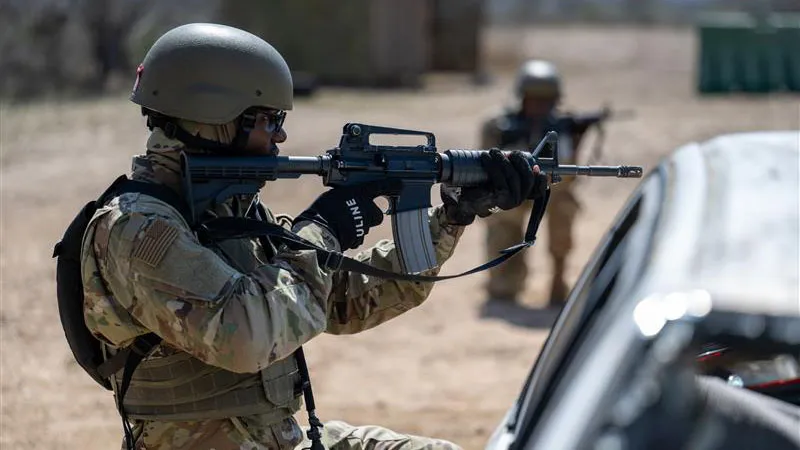
The United States Air Force has extended the duration and complexity of the capstone training exercise for new recruits, ensuring that airmen face rigorous challenges in training so they are better prepared for the realities of war.
The three-day PACER FORGE event—short for Primary Agile Combat Employment Range Forward Operations Readiness Generation Exercise—has been expanded from 36 to 57 hours, with the first group of recruits completing the updated version earlier this week.
According to the Air Force, PACER FORGE, which takes place during the sixth week of Basic Military Training (BMT), immerses recruits in the opening hours of a simulated deployment.
Elon Musk Called This Financial News ‘Terrifying’
The event now includes additional intelligence briefings and requires trainees to form and operate within small teams earlier in the exercise.
“Trainees will be provided complex scenarios that include building and defending operating locations, recovering high-value assets, conducting resupply drops, and providing Tactical Combat Casualty Care,” said Angelina Casarez, spokesperson for the 37th Training Wing.
“Skills such as radio procedures and building tents learned earlier in BMT will be applied in practical exercises at PACER FORGE.”
One of the primary objectives of the enhanced PACER FORGE is to foster greater independence and problem-solving abilities among trainees. While the extension gives them more time to navigate their missions, it also reduces direct guidance from instructors.
American Made Patriotic Apparel – Save 15% with Promo Code MERICA
This shift places more responsibility on the trainees to use critical thinking, teamwork, and adaptability—essential skills for real-world combat operations.
“Trainees are challenged to make decisions under pressure, manage their time effectively, and adapt their plans as scenarios evolve,” Casarez explained.
Despite the increase in training hours, the amount of sleep trainees receive during the event remains unchanged. However, the intensity of the exercise has been significantly heightened, reinforcing the Air Force’s commitment to preparing airmen for operational readiness.
Air Force Chief of Staff Gen. David Allvin praised the changes to PACER FORGE as a pivotal enhancement to BMT. “We’ve taken things to the next level at @USAirForce Basic Military Training, expanding the culminating event to drive home the #WarriorEthos and better prepare Airmen to defend this great country,” Allvin wrote in a post on X.
Lt. Gen. Brian S. Robinson, head of Air Education and Training Command, echoed this sentiment during the Air & Space Forces Association Warfare Symposium in Aurora, Colorado. He emphasized that the adjustments shift the exercise from being instructor-driven to a more mission-oriented approach.
“Instead of being overly prescriptive by [instructors], what happens now is ‘here’s the objectives you’re set to achieve, here’s the resources available to you … you have 57 hours to solve this problem and try to achieve the objective,’” Robinson was quoted as saying by Air & Space Forces Magazine.
PACER FORGE was first introduced in 2022 as a replacement for the Basic Expeditionary Airman Skills Training (BEAST), which had been the final test of BMT since 2006.
BEAST was a four-day exercise that mirrored the combat scenarios U.S. forces faced in the Global War on Terrorism, including simulated mortar attacks, roadside bombs, unexploded ordnance, and complex assaults.
Unlike BEAST, which involved larger unit formations, PACER FORGE organizes trainees into smaller, more dispersed teams. This change aligns with modern combat strategies that emphasize agility, teamwork, and decentralized decision-making. A 2022 Air Force news release highlighted this new approach.
“What we are doing is making them [trainees] ready to join any team, to work well together, to solve tough problems, to be good wingmen and teammates, and to innovate,” said Col. Jeff Pixley, then commander of the 737th Training Group.
Military Training Instructor Tech Sgt. Shayla Blakeney described PACER FORGE as a “mock deployment” that simulates real-world operations with minimal instructor intervention.
“Cadre is the overseer and will give them tidbits of information. But at the end of the day, that environment out there is trainee-led,” Blakeney said in a 2024 interview. “All of the information that they’ve learned, like the expeditionary things that they learned in weeks 3 and 4, they’re required to execute it out there.”
The evolution of PACER FORGE reflects the Air Force’s broader efforts to ensure its newest airmen are combat-ready upon entering the operational force.
By placing recruits in high-stress environments where they must rely on their training and each other, the Air Force aims to cultivate a new generation of adaptable, resourceful, and resilient warfighters.
With threats evolving and conflicts becoming increasingly complex, these changes in BMT reinforce the service’s commitment to maintaining a force capable of responding swiftly and effectively in real-world scenarios.
By expanding PACER FORGE, the Air Force is not only enhancing training but also reinforcing the warrior ethos that defines America’s airmen.
The opinions expressed by contributors and/or content partners are their own and do not necessarily reflect the views of LifeZette. Contact us for guidelines on submitting your own commentary.





![Trump's Admin Guts Another ‘Rogue Government Agency with Zero Accountability’ [WATCH]](https://www.right2024.com/wp-content/uploads/2025/03/Trumps-Admin-Guts-Another-‘Rogue-Government-Agency-with-Zero-Accountability-350x250.jpg)



![‘We All Owe Him (Elon) a Huge Debt of Gratitude’ [WATCH]](https://www.right2024.com/wp-content/uploads/2025/03/‘We-All-Owe-Him-Elon-a-Huge-Debt-of-Gratitude-350x250.jpg)
![NCAA Champ Salutes President Trump After ‘BIGGEST UPSET IN COLLEGE WRESTLING HISTORY’ [WATCH]](https://www.right2024.com/wp-content/uploads/2025/03/NCAA-Champ-Salutes-President-Trump-After-‘BIGGEST-UPSET-IN-COLLEGE-350x250.jpg)






